We can’t be certain how or when exactly the Hay Street Office began.
What we do know is that Bill Castles (who had never married) and Tubby McGhee had in his later years, taken up permanent rooms at the Savoy Hotel, Hay Street Mall and were instrumental in establishing the Hay Street Office of the 2/4th, meetings were held on the seating in the Mall outside the hotel. In fact Bill was probably the President, Public Relations Officer and Registrar. All former POWs knew to catch up with Bill and others in the Mall.
Bill and Tubby were both Goldfields boys although Tubby in his early teens moved to Perth with his family.
Returning from war, Bill returned to his hometown of Kalgoorlie and worked as a miner. He was recorded in the 1949 Electoral Roll. He soon afterwards moved to Perth and took up employment at Hollywood Hospital.
It was outside in the Mall or nearby, that Billy, ‘Tubby’ and others could be seen seated having a good old catch up and chat.
Now the Hay Street Office closed in the afternoons! Afternoons were put aside for lunch and rest/sleep.
Built in 1910 the Savoy closed permanently on 19 May 1991 and Bill Castles loses his home. (Today in 2022, the Savoy is closed and is to be put to other uses. Fortunately there is progress being made to preserve some of the beautiful architectual features and fittings ).
‘Savoy Theatre was located in the basement of the Heritage listed Savoy Hotel. The space was originally a billiard hall, and was converted into the Savoy Newreel Theatrette which opened 23rd December 1955. It operated as a newsreel theatre, also screening short subjects and cartoons, in one hour long programmes.
Due to the arrival of television, the Savoy Theatrette went over to screening full length feature films from mid-1959. In 1975, the programming policy changed to R-Rated adult films. It was closed in August 1991.’
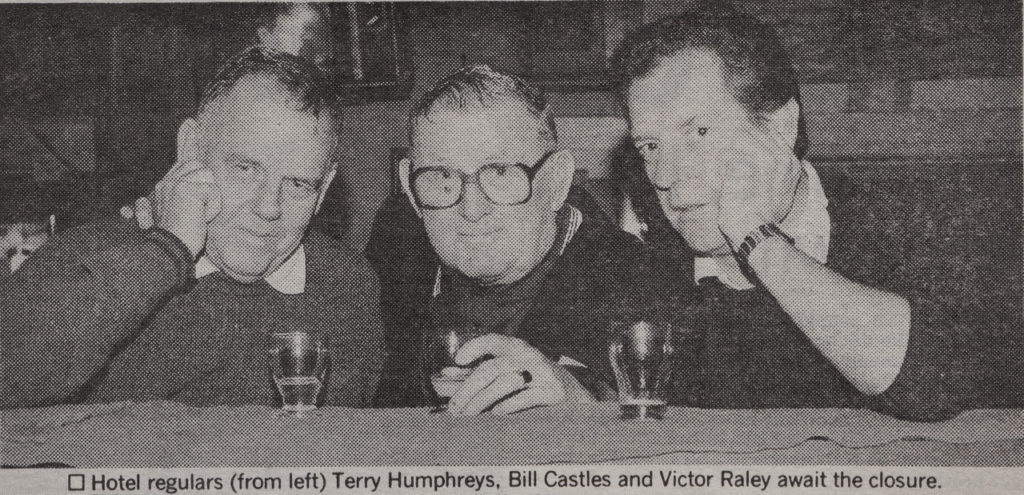
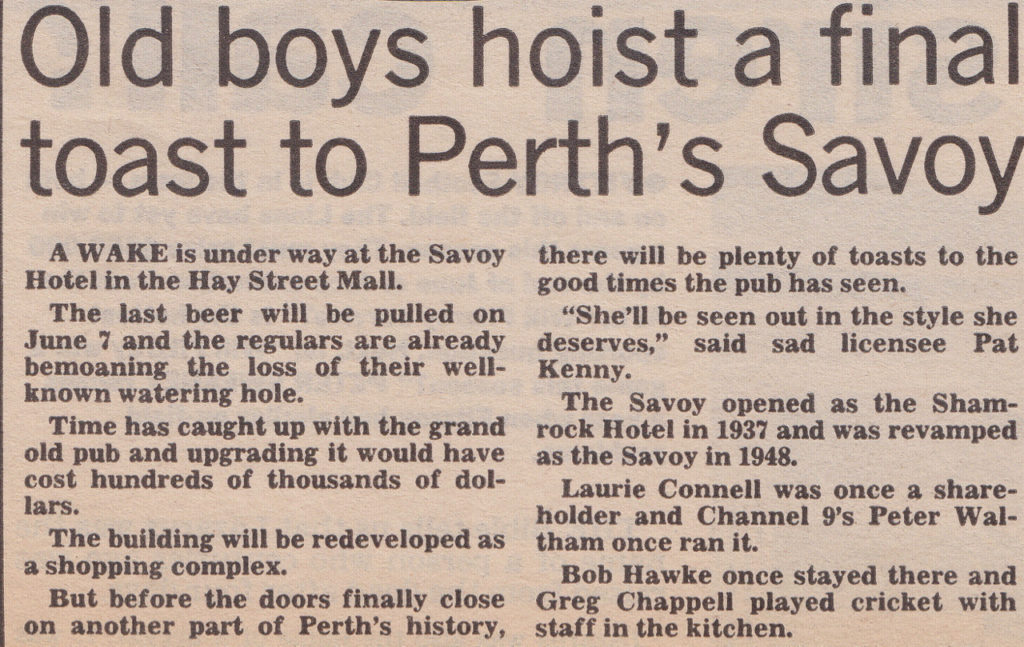
Vale W.T. (Bill) Castles (Borehole Bulletin April 1992)
On Christmas Day 1991, our long standing Committeeman Bill Castles passed away.
With Bill’s passing a long association with ex-members of our Battalion and all Jap POWs ended and the Hay Street Office closed.
Bill had a long association with the ‘Borehole Bulletin’ in the early years of publication he wrote about different members he met in various places around the state and in the Eastern states. He was employed at Hollywood Hospital and never missed called on battalion members. When he retired he still visited Hollywood and reported progress on the different men who were admitted. Bill used to make a country run every now and again and call on all the various members in all the towns he could.
Each year with a couple of mates, he would travel to Tasmania to the 2/40th Btn. Reunion and bring back a lot of news from the Apple Isle.
All interstate and country ex Japanese POWs were able to get information from Bill in the Hay Street Mall, our Perth ‘Office’. Bill was a mind of information on members, what they were doing and where they could be found. He will be sadly missed.
There was a large contingent of 2/4th and other POWs at his funeral in January (1992).
Rest In Peace – Bill
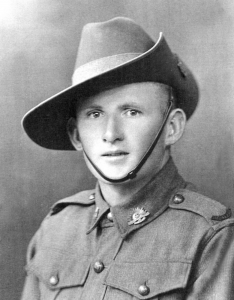
WX8792 Cpl Wilfred Thomas Castles – Scout ‘B’ Company 8 Platoon under Commanding Officer Lt MacKinnon. Please read about ‘B’ Company 8 Platoon.
Castles left Singapore May 1942 by ship with the first work force to leave ‘A’ Force Burma, Green Force No. 3 Battalion.
The 3,000 Australian POWs would first sail to south west Burma where they repaired and enlarged three airfields left behind by the British. By 1 October 1942, they began working on the Burma end of the Burma-Thai Railway and continued until the end of 1943 when the Japanese began moving all POWs in Burma (and Thailand) to one of several very large camps or hospital camps in Thailand.
Bill Castles was evacuated sick 5 July 1943 to the largest hospital Camp in Burma called Khonkan 55km. A hospital camp without medicines or medical equipment! There were men with ulcers, dysentery, malaria, etc.
It is believed Bill was evacuated from Khonkan, Burma to Tamarkan Hospital Camp in Thailand by end of 1943. From Tamarkan he was sent to Kanchanaburi, Hindato Camp, Chungkai (mostly a hospital camp), Ratburi, Petchaburi, Bangkok and was recovered from Nakom Nayok at the end of the war.
The following is from Danny’s Diary from the time he arrived in Thailand from Burma, January 1944, it is also the story of Bill Castles:
‘Tamarkan, Thailand 2 Jan 1944 – Bevis arrived as part of the whole contingency plan by the Japanese to move all the POWs in Burma, south to Thailand to one of 4 or 5 large camps or hospitals.
‘Food good for six weeks to build up the Japan Party, later torpedoed. Camp is 60 yards from bridge of eleven steel spans and large AA position. Surrounded by observation posts, Nip engineers, cavalry camp and railway line. Twenty one planes over 29 Nov 1944. Four bombs dropped on camp, 18 killed and 38 wounded.
Non Pladuk ,Thailand 30 Nov 1944 – 62 buildings, workshops, etc. wiped out. Bombs and bullets in camp 93 killed and 310 wounded.
Kanchanaburi, Thailand bombed 13 Dec 1944.’
Tamarkan Camp, Thailand
‘Several more raids in December, quiet until 28 Jan 1945. Wooden bridge destroyed and repaired by us. One plane, one bomb, lost one whisky.
5th Feb 1945 – AA half a mile from camp, nip engineers and bridge bombed, 1,000 lb.
23 May 1944 – First Red Cross parcels received. 6 men to one parcel.
28 May 194 – First mail.’
Chungkai Camp, Thailand
‘Left Tamarkan 12 Feb 1945. March over bridge 6 km to Chungkai. Broke all records going over. Arrived same day.
13 Feb 1945 – bridge blown to pieces.
19 Feb 1945 – left Chungkai.’
Non Pladuk Camp, Thailand
‘Arrived 20 Feb 1945. Spent night of expectancy as previous raid very noticeable. Nothing standing except portion of POW Camp. In train four hours before leaving for Kachu Mountain on 21 Feb 1945. Detrained as blown bridge at Ratburi. Thai’s hostile to Nips. Pontoons over river.’
Kachu Mountain, Thailand
‘March to Kachu Mountain 86 km (53 miles). Self picked up in truck 15 miles out (sick with malaria) and arrive Kachu Mountain 22 Feb 1945. The rest (POWs) arrive in a bad way on 24 Feb 1945. Building two aerodromes No. One 8 kms from POW Camp. No. two, 3 kms from POW Camp. (Remember POWS had to work to and from work back to their camps – 8 and 3 kms is a long way when you are sick and exhausted at the end of the day) Conditions and Nips no Good. Self malaria all the time, nearly passed out.
28 April 1945 – 26 planes go over strafing the aerodrome. Machine Gun mounted by Nips outside hospital hut. Plenty Blackwater fever. Storms every night. 7 huts blown down in typhoon. I eat python and armadillo, not too bad.’
July 1945 – 1,000 POWs were transferred from Kachu Mountain Camp to Petchaburi, Thailand.’
Petchaburi, Thailand
‘Left Kachu Mountain 1 July 1945 marched to Petchaburi (18 miles). Self in truck after 10 miles, malaria again.’
Ratburi, Thailand
‘Train to Ratburi, damage of previous planes evident. Stopped for night sitting up. Chinese say war one more month, he was right.’
Nacompaton, Thailand
‘Through Nacompaton, largest pagoda ever seen. There are hundreds of legless and armless POWs here, bridge blown to pieces.’
Nacompaton had been set up from Dec 1943 as a large hospital and convalescing camp. There were several members from 2/4th involved with the construction of this camp, including Eric Fraser and Frank ‘Blue’ Evans. This is where men like Tom Barbour, Syd Gorringe, Eric Ryan and Allan Bamford to name a few who had limbs amputated, and would remain here until the end of the war. The camp itself was located about 30 miles to the west of Bangkok. As well as amputees (amps) there were many POWs sent to this camp to build sup their strength following the construction of the rail link. As their health improved slightly they were again called upon to depart Nacompaton on work parties. On Japan’s surrender in August 1945 Nacompaton became an Allied Forces collection centre for ex POWs who were then either moved out via Bangkok to Singapore direct or via Rangoon to Singapore.
Bangkok, Thailand
‘Arrive Bangkok 3 July 1945. Bombs have wreaked havoc at station and railway workshops. Took barge to go-downs. Big raids two weeks previous. Lofty Holdman, (from 2/4th) killed, roofs wrecked. Do not like it here very much. Left go-downs 6 July 1945. Arrive Kanchanburi 6 July 1945. Left 0100 hours 7 July 1945 for Nakom Nayok.’
Nakom Nayok, Thailand
‘March was murderous and at end of 45 kms men were all in. Nips would not pick up sick. Had been going with no food or boots for 33 hours continuous. Tried to refuse to march when 3/4 of distance was covered on account no water, but rifle and bayonet won the argument, so we staggered on. Arrived Nakom Nayok on 7 July 1945. Long hours and hard work digging dugouts, ammo dumps, etc. in hills 8 km away. Plenty of lightning and storms under water constantly. Cannot dig latrines on account of water. Cement bags were split for cigarette papers. Left Nakom Nayok 4 August 1945.’
Work for POWs at Nakom Nayok consisted mainly of digging. The digging of trenches or tunnels into the side of a hill to store supplies and petrol drums, thought to have been aviation fuel for the IJA Air Service.
Lopburi, Thailand
‘Arrive Lopburi 4 Aug 1945. 100 yards to two tarmacs, three transmitting stations and trucks, petrol dumps, hangers and nips galore. Surrounded by military objectives and confined to an area 75 yards square, under tents. 200 in party and instructed that if any air activity not to move out of area or would be shot. One B29 over and all keyed up for eventualities as one nip plane came from hanger to have a go at him. Nothing happened, nip plane crashed. Self route planned for escape if needed.’
Nakom Nayok, Thailand
‘Told on evening of 16 Aug 1945 that we were to move back to Nakom Nayok next morning 17 Aug 1945. Thai’s shower truck with food etc. and we had an idea something had happened.’
‘On arrival at Nakom Nayok we were elated to see Yank, British and Dutch flags flying and were notified that war had finished. Plane dropped men and supplies on 1 Sep1945, what a sight. One man through roof of hut, also some parcels when chute failed to open. Again on 3rd and 4th September more supplies, clothes and medicine. One plane dare devil flyer, very exciting. Lady Edwina Mountbatten visits camp.’
Bangkok, Thailand
‘Left Nakom Nayok 13 Sept 1945. Arrive Bangkok at Tamasaart University 13 Sept. Wonderful buildings, King’s Palace, pagoda, etc. in Bangkok. On 24 Sept left Bangkok 0850 hours Don Muang Aeorodrome and flew 900-1,000 miles to Singapore, arriving 5 hours 25 minutes flying time at 1415 hours. Bad weather on leaving, crossed Gulf of Siam and South China Sea, thence east coast of Malaya. Views of paddy fields, river and jungles, magnificent. Had a couple of nasty bumps over South China Sea. All Aussie crew onboard a Dakota plane. Height mostly 10,000 feet. Present quarters at Singapore just like civilization again and had my first drink of beer in 3 3/4 years. This was a record. Left Singapore on ‘Tamaroa’ 29 Sept 1945.
Home, West Aussie at last, 10 October 1945.’
Below: Far Left: Billy Castles, L-R Ted Feltham and Rod Gibons and wives.
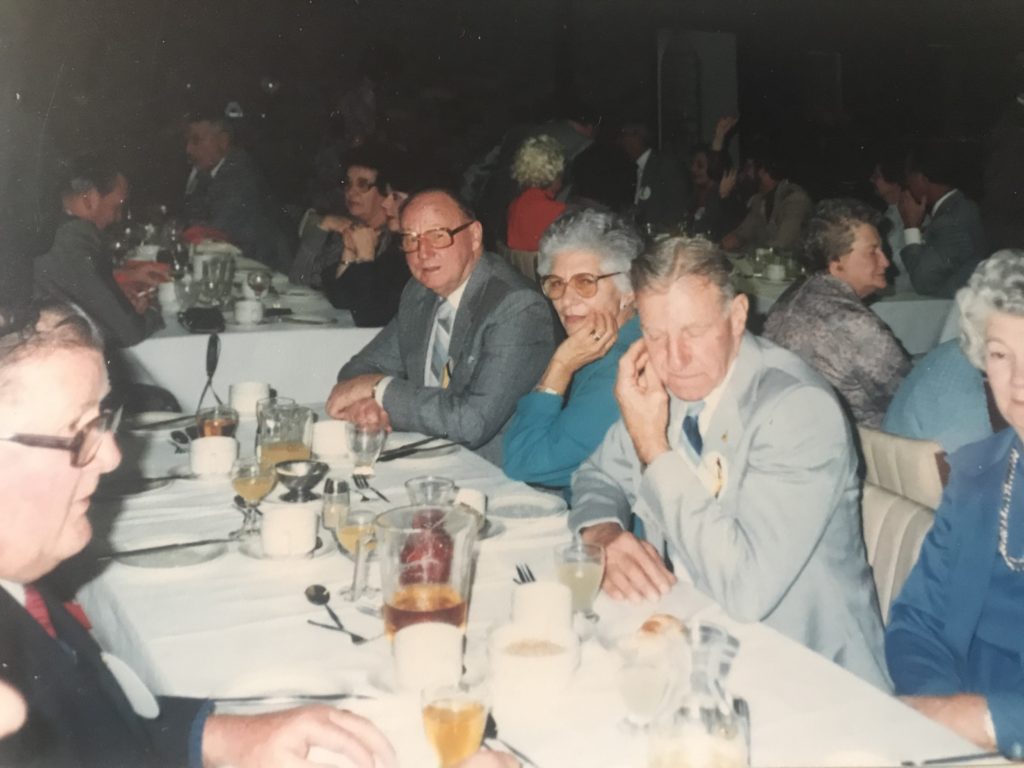
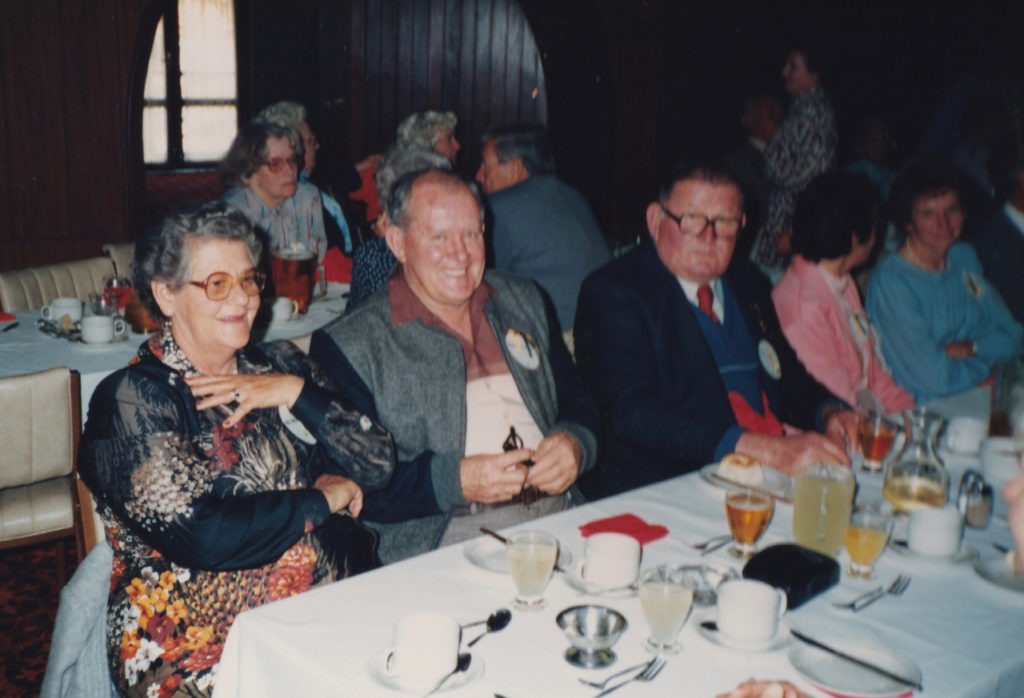
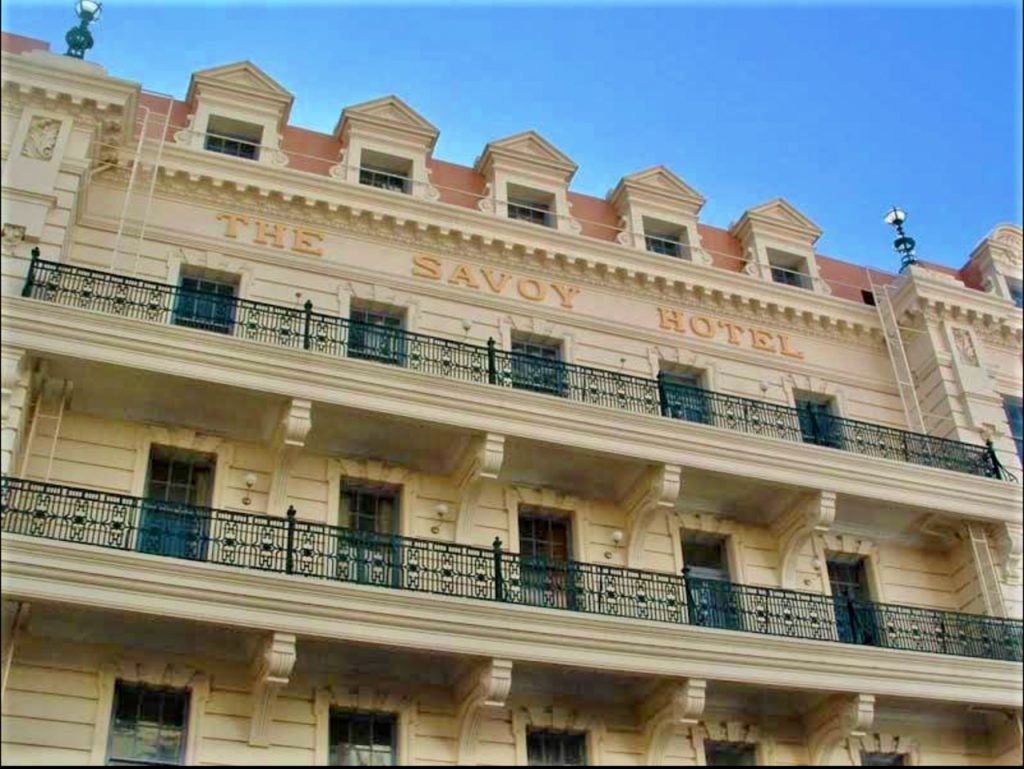
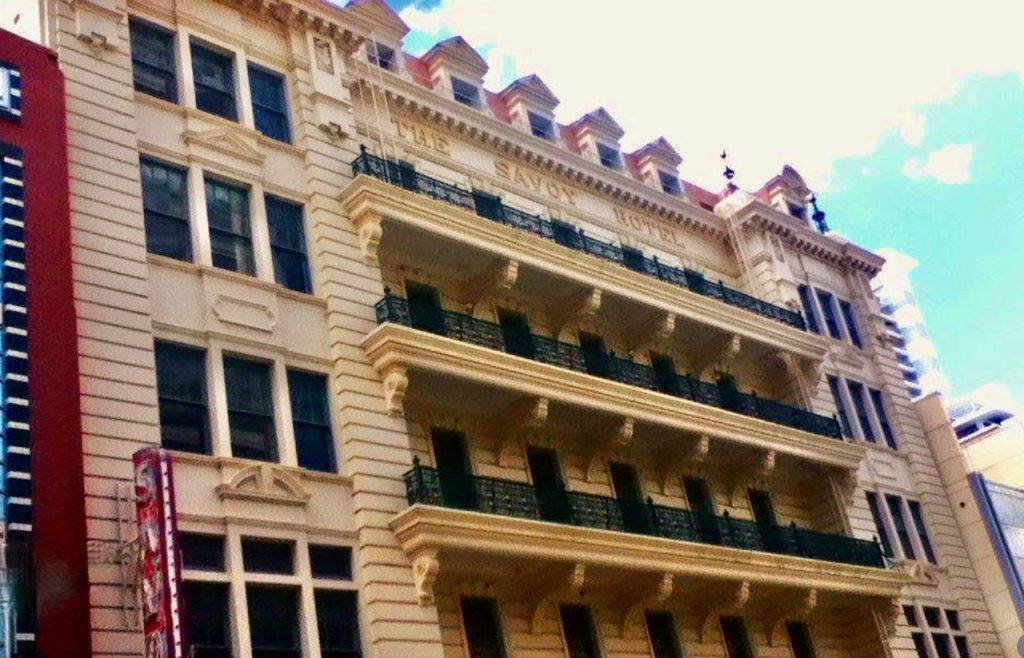
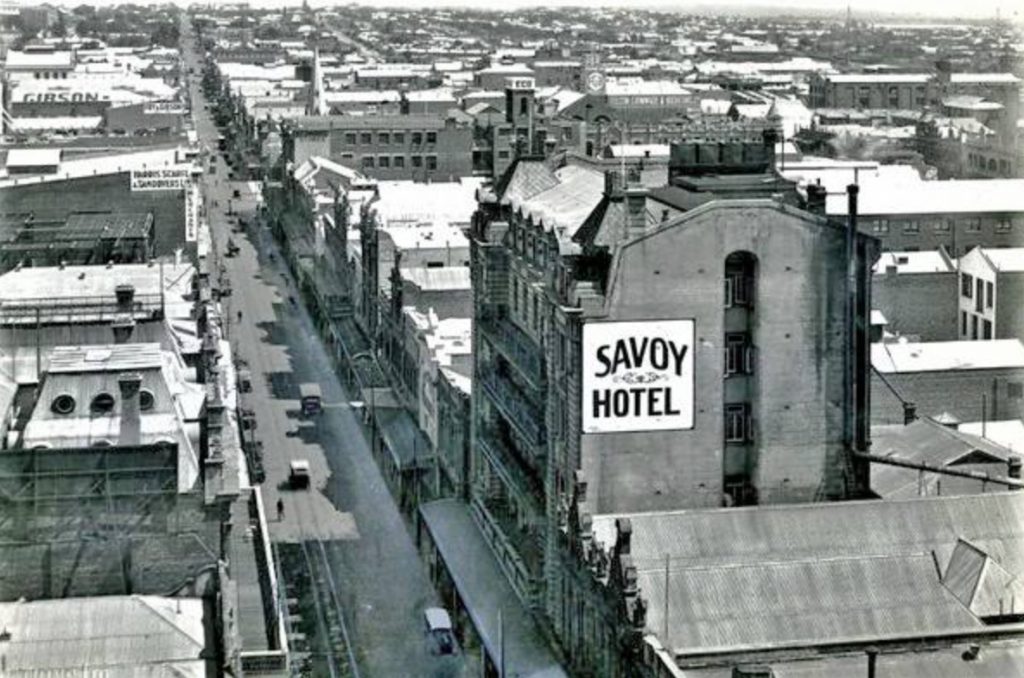
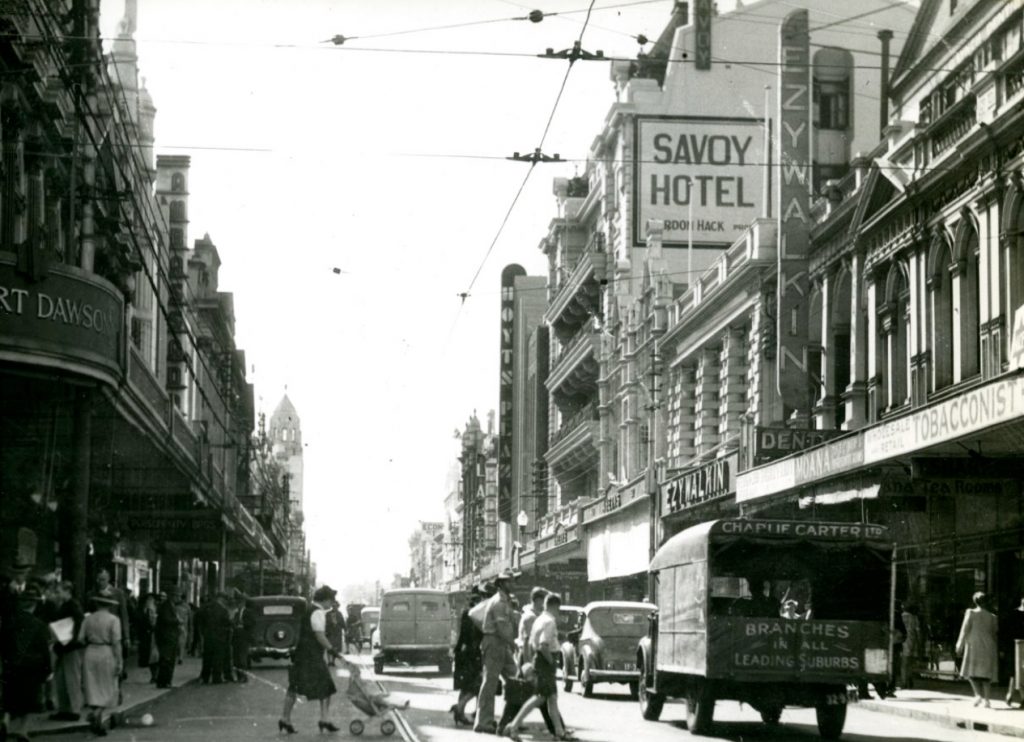
We wish to acknowledge WA Museum and Lost Perth for the above Black and White photos.
Below: Harold Cowie, Billy Castles and Tubby McGhee.
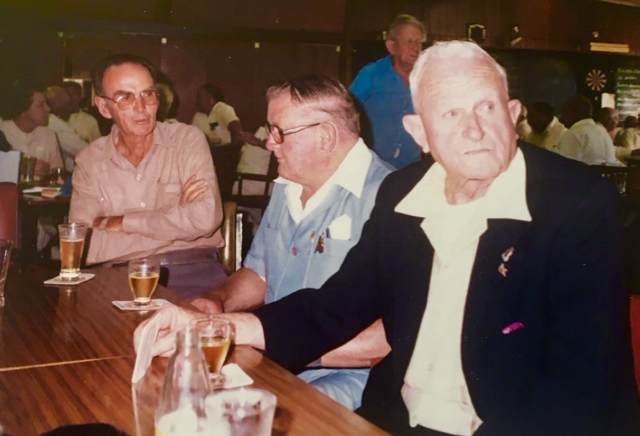

WX9145 Alfred Joseph (known as Tubby) MGhee was born 1906 Coolgardie. We believe Tubby spent his formative years in the Goldfields before his family moved to Perth (before mid 1920’s)O. He enlisted AIF 30 Oct 1940 from Scarborough and later joined 2/4th’s ‘A’ Company 5 Platooon.
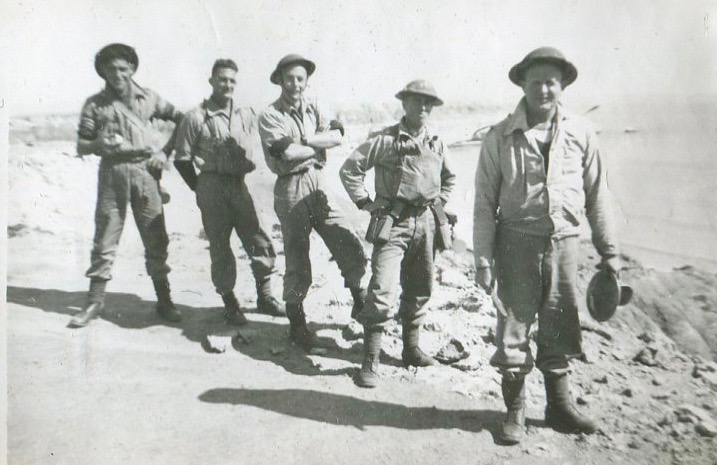
Most of us will remember a visit to Boans with our Dads – ‘Tubby’ McGhee was a life operator. He had suffered a leg amputation following an ulcer of his leg in Burma whilst working on the line.
McGhee was selected with the first work party to leave Singapore – ‘A’ Force Burma, Green Force No. 3 Battalion – (Green Force which included a very large number of 2/4th men as did ‘D’ Force S Battalion). Made up of 3,000 POWs, ‘A’ Force sailed for south west Burma coast in May 1942 where Green Force would first work on repairing and enlarging the aerodrome at Victoria Point. They remained working here for several months before making their way to the northern most point of Burma-Thai Railway and began work 1 October 1942 at Kendau 4.8km.
They worked on the rail link until December 1943 after which the Japanese moved all the POWs in Burma, south to one of the larger camps in Thailand.
Read further about A Force Burma, Green Force
McGhee was evacuated to Khonkan 55km Camp Hospital on 6 November 1943 from Angganaung 105km Camp with tropical ulcers. His leg was amputated on 4 January 1944 at Khonkan Hospital Camp. It was amazing he survived this as so many others died. Kohnkan could hardly be called a hospital – Albert Coates was Surgeon here. Coates had no medical equipment nor medicines.
McGhee was evacuated to Tamarkan Camp in Thailand on on 27 April 1944.
He was sent to Bangkok on 26 April 1944, and onto Nacompaton Hospital Camp from where he was recovered on 24 August 1945 at the end of the war.
Please read further about Khonkan Hospital Camp
Please read a 1953 journalist’s story of the life of POWs on the Burma-Thai Railway. Mentioned is Tubby McGhee.
After the war McGhee found work as a lift operator at Boans Department Store. His mates from 2/4th would make an effort to visit him during working hours, often taking their children as riding in a lift was rather wondrous and special during the 1950’s and 1960s.
Alfred married to Phyllis Maude McBrearty prior to his departure with 2/4th. They divorced in 1949.
McGhee’s parents William James McGhee (born SA 1872) and Isabella Jane Leng (Born Victoria) married Kalgoorlie about 1901. Alfred was their 4th son. There were also three daughters – all were born Boulder or Kalgoorlie. We believe the McGhee family left Kalgoorlie by mid 1920’s.
By the 1930’s William and Isabella were residing in Shenton Street, Claremont. In 1936 Alfred was living with them along with several sisters.
William James McGhee died in 1958 and Isabella died in 1973.
In 1963 the Electoral Roll shows Alfred residing with his mother at Glendalough, in 1980 Alfred was residing in Adelaide Terrace, East Perth. He was retired.
Tubby McGhee died on 29 November 1989.
